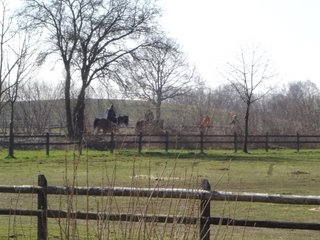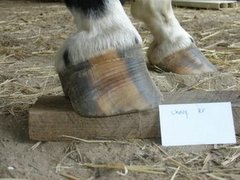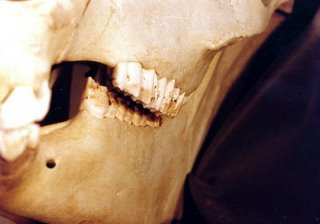Equisearch.com

Check out my new favorite web site,
www.equisearch.com It has a lot of educational information on it along with some interesting blogs.
This is a picture I took in Germany.
Misty Valley Equine is the name of my veterinary practice. The vast majority of my practice is devoted to diagnosing and treating performance horse lameness issues.

Check out my new favorite web site,
www.equisearch.com It has a lot of educational information on it along with some interesting blogs.
This is a picture I took in Germany.
 This is a picture of a large gastric ulcer in a horse taken with a 3 meter endoscope. The red area is the ulcer. Gastric ulcers in horses are much more common than one would think. Many scientific reports give a prevalence of 50-90% depending on activity type, feed intake, and management. The clinical signs of ulcers can be quite vague and nonspecific, but probably the most common finding associated with gastric ulcers are related to feed consumption. Horses with ulcers typically take longer to consume their feed and owners/trainers report that it is more difficult maintaining good body condition in these animals. I also have seen depression as a clinical sign, ears down, dull look, are both signs of depression.
This is a picture of a large gastric ulcer in a horse taken with a 3 meter endoscope. The red area is the ulcer. Gastric ulcers in horses are much more common than one would think. Many scientific reports give a prevalence of 50-90% depending on activity type, feed intake, and management. The clinical signs of ulcers can be quite vague and nonspecific, but probably the most common finding associated with gastric ulcers are related to feed consumption. Horses with ulcers typically take longer to consume their feed and owners/trainers report that it is more difficult maintaining good body condition in these animals. I also have seen depression as a clinical sign, ears down, dull look, are both signs of depression.
 Have you ever seen an old horse with it's hind fetlocks dropping down close to the ground? Well if you have, this is what's going on inside the leg. Inside the box is the branch of the suspensory ligament where it attaches to the sesamoid bone. The red area of the ligament is showing how inflammed it is and the attachement to the bone is almost gone. The function of the suspensory ligament is to "suspend" the fetlock up off the ground. When the ligament breaks down, the fetlock drops.
Have you ever seen an old horse with it's hind fetlocks dropping down close to the ground? Well if you have, this is what's going on inside the leg. Inside the box is the branch of the suspensory ligament where it attaches to the sesamoid bone. The red area of the ligament is showing how inflammed it is and the attachement to the bone is almost gone. The function of the suspensory ligament is to "suspend" the fetlock up off the ground. When the ligament breaks down, the fetlock drops. 
 Club Foot - A club foot is one that has a foot axis (angle created between the ground and the front of the foot) of 60 degrees or more. This horse has a hoof angle of 70.5 degrees. A club foot can arise in one of two ways. 1.) It can develop secondary to an injury that has prevented proper use of the foot, leading to contracture of the deep digital flexor tendon and the foot, or 2.) It can may be inherited or due to a nutritional deficiency/excess as a foal. This will lead to contracture of the deep digital flexor tendon, pulling the coffin bone back as it contracts. This condition can be helped if treated early when the horse is still young. There are medical and surgical treatments that can be performed, depending on the individual case.
Club Foot - A club foot is one that has a foot axis (angle created between the ground and the front of the foot) of 60 degrees or more. This horse has a hoof angle of 70.5 degrees. A club foot can arise in one of two ways. 1.) It can develop secondary to an injury that has prevented proper use of the foot, leading to contracture of the deep digital flexor tendon and the foot, or 2.) It can may be inherited or due to a nutritional deficiency/excess as a foal. This will lead to contracture of the deep digital flexor tendon, pulling the coffin bone back as it contracts. This condition can be helped if treated early when the horse is still young. There are medical and surgical treatments that can be performed, depending on the individual case. 
 This is a picture of a skull, looking from the muzzle, back towards the horse. It demonstrates how a horses upper molars overhang the lower molars. I put this picture in here to let people know that if your horses teeth become sharp from improper wear, the cheekpiece of the bridle can then cause pain by pushing the cheek into the sharp points that overhang on the upper molars. If your horse is doing a lot of head tossing when you pull back on the reins, this may be a sign that it's teeth are sharp and need to be examined by your veterinarian.
This is a picture of a skull, looking from the muzzle, back towards the horse. It demonstrates how a horses upper molars overhang the lower molars. I put this picture in here to let people know that if your horses teeth become sharp from improper wear, the cheekpiece of the bridle can then cause pain by pushing the cheek into the sharp points that overhang on the upper molars. If your horse is doing a lot of head tossing when you pull back on the reins, this may be a sign that it's teeth are sharp and need to be examined by your veterinarian. 